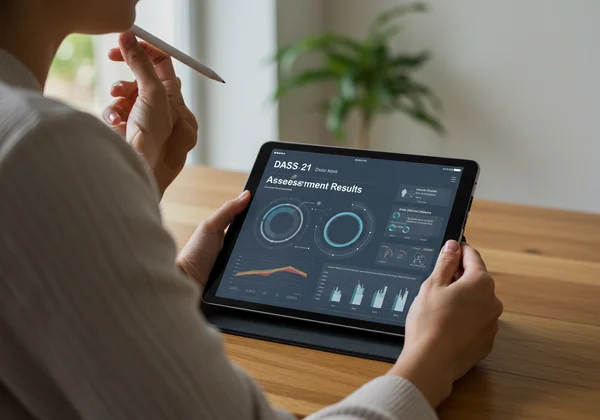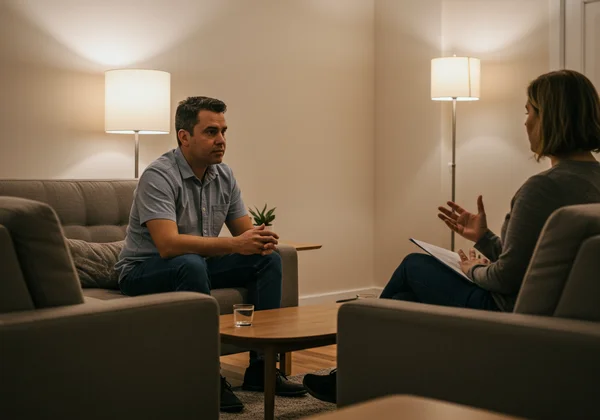High DASS-21 Anxiety Score: Online Assessment Interpretation, Calming Strategies & Support
Receiving a high DASS-21 anxiety score can feel alarming, but it's important to see it for what it is: a valuable piece of information. This score isn't a diagnosis or a label; it's a signal from your mind and body that it's time to pay attention. If you've just completed the assessment and are wondering, What to do with my DASS21 results?, you've come to the right place. This guide is designed to help you understand your score, provide immediate calming techniques for moments of overwhelm, and offer long-term strategies to build resilience. Your journey toward understanding and managing anxiety starts with this single, empowering step.

Your score is a starting point, a way to understand your emotional state and begin a path toward greater well-being. Let's walk through it together.
Understanding Your High DASS-21 Anxiety Scores & Interpretation
Before we explore coping strategies, it’s crucial to understand what your score represents. The Depression, Anxiety, and Stress Scale (DASS-21) is a well-established screening tool that helps differentiate between these three common emotional states. A high score on the anxiety subscale points to a significant presence of symptoms over the past week.
DASS-21 Anxiety Score Interpretation: What Your Results Mean
The anxiety scale of the DASS-21 specifically measures physical arousal, panic attacks, and fear responses. This can include symptoms like a racing heart, trembling, or persistent, apprehensive worry. It’s essential to remember that this is a self-assessment, not a clinical diagnosis. It reflects your personal experience of these symptoms. Think of it as a smoke detector; it alerts you to potential fire, but it doesn't tell you the cause or size of the flame. Your score is an invitation to explore your feelings more deeply. For a detailed dass 21 score interpretation, you can review the severity ratings on our site after completing the test.
Common Physical & Emotional Signs of High Anxiety
Recognizing the signs of anxiety is the first step toward managing them. When your score is high, you may be experiencing a combination of these common symptoms:
- Physical Signs: A racing or pounding heart, shortness of breath, trembling or shaking, dry mouth, stomach distress, and feeling dizzy or lightheaded. These are often part of the body's "fight or flight" response.
- Emotional Signs: Persistent worry or a sense of dread, feeling on edge or irritable, difficulty concentrating, and fearing that something terrible is about to happen. These feelings can be exhausting and feel uncontrollable.
Identifying which of these signs are most present for you can help you choose the most effective coping strategies.
Coping with Anxiety: Immediate Calming Strategies
When anxiety spikes, it can feel like you’re losing control. Having simple, powerful techniques at your fingertips can make all the difference. These strategies are designed to interrupt the anxiety cycle and bring you back to a state of calm.
Breathwork: Simple Techniques for Instant Relief
Your breath is your body’s built-in calming system. When you're anxious, your breathing becomes shallow and rapid, which can worsen physical symptoms. By consciously slowing your breath, you signal to your nervous system that it's safe to relax.
Try Box Breathing:
-
Inhale slowly through your nose for a count of four.
-
Hold your breath for a count of four.
-
Exhale slowly through your mouth for a count of four.
-
Hold your breath at the end for a count of four.
-
Repeat this cycle for several minutes until you feel more centered.

Grounding: Reconnecting with the Present Moment
Anxiety often pulls our minds into worrying about the future. Grounding techniques anchor you in the present moment by focusing your attention on your five senses.
The 5-4-3-2-1 Method: Wherever you are, take a moment to notice:
- 5 things you can see around you.
- 4 things you can physically feel (the chair beneath you, the texture of your clothes).
- 3 things you can hear (the hum of a computer, distant traffic).
- 2 things you can smell (coffee, a book).
- 1 thing you can taste (water, your own breath).
This simple exercise shifts your focus away from anxious thoughts and back to your immediate surroundings. You can monitor your progress by noticing how these techniques impact your feelings over time.
Progressive Muscle Relaxation: Releasing Physical Tension
Anxiety creates physical tension in the body, often without us realizing it. Progressive muscle relaxation involves tensing and then relaxing different muscle groups to release this stored stress. Start by tensing the muscles in your toes for five seconds, then release for thirty seconds. Work your way up your body—calves, thighs, abdomen, arms, and face—until your entire body feels relaxed.
Building Resilience: Long-Term Anxiety Management Techniques
While immediate strategies are vital for acute moments of panic, long-term resilience is built through consistent, healthy habits. These anxiety management techniques help reduce the overall frequency and intensity of your anxiety over time.
Mindfulness & Meditation for Daily Peace
Mindfulness is the practice of paying attention to the present moment without judgment. Regular meditation can literally rewire the brain to be less reactive to stress. You don't need to sit for hours; just five to ten minutes a day can have a profound impact. Try using a guided meditation app or simply focusing on your breath to start.
The Power of Lifestyle: Sleep, Nutrition, & Movement
Your mental health is deeply connected to your physical health.
-
Sleep: Aim for 7-9 hours of quality sleep per night. Lack of sleep can significantly increase anxiety levels.
-
Nutrition: A balanced diet rich in whole foods can stabilize your mood. Be mindful of caffeine and sugar, which can trigger or worsen anxiety.
-
Movement: Regular physical activity is one of the most effective tools for managing anxiety. Even a 20-minute walk can release endorphins and reduce stress.

Setting Healthy Boundaries to Reduce Stress
Often, anxiety is fueled by external stressors, such as overwhelming workloads or draining relationships. Setting healthy boundaries means learning to say "no" to protect your time and energy. It's not selfish; it's an essential act of self-care that reduces the sources of your stress.
Journaling for Emotional Processing & Self-Awareness
Writing down your thoughts and feelings can be incredibly therapeutic. It helps you identify your anxiety triggers and negative thought patterns. Try a "brain dump" where you write whatever comes to mind for 10 minutes, or use specific prompts like, "What am I most worried about right now?" and "What is one small step I can take to address this worry?" Over time, you can take the free assessment again to see how these practices are affecting your score.
Getting Professional Anxiety Support
Self-help strategies are powerful, but sometimes they aren't enough. There is immense strength in recognizing when you need professional support. The DASS-21 is an excellent tool for starting a conversation with a mental health professional.
Recognizing Red Flags: When Symptoms Persist or Worsen
It might be time to seek help if your anxiety:
- Persistently interferes with your work, school, or relationships.
- Causes you significant distress on most days.
- Leads to panic attacks frequently.
- Is not improving or is getting worse despite your efforts.
Types of Mental Health Professionals & How They Can Help
- Therapists/Counselors: Provide talk therapy (like Cognitive Behavioral Therapy, or CBT) to help you develop coping strategies.
- Psychologists: Can provide therapy and conduct more in-depth psychological assessments.
- Psychiatrists: Are medical doctors who can diagnose mental health conditions and prescribe medication if needed.
Preparing for Your First Mental Health Appointment
Feeling nervous about your first appointment is normal. To prepare, consider writing down your main concerns, listing your symptoms (your DASS-21 results can be a great starting point), and thinking about what you hope to achieve. Remember, this is a collaborative process aimed at helping you feel better. A tool like your confidential self-assessment can provide a clear snapshot to share.

Taking Your Next Steps Towards Greater Calm
A high DASS-21 anxiety score is not a final destination; it is a signpost on your mental health journey. It has given you the awareness and the motivation to take action. You've already taken the first step by seeking out information. By integrating the immediate calming techniques and long-term management strategies from this guide, you can begin to build a life with less anxiety and more peace.
Remember that self-monitoring is a key part of this process. We encourage you to return to our platform to start your DASS21 assessment periodically. Tracking your scores over time can provide valuable feedback on your progress and help you see just how far you've come.
Frequently Asked Questions
Is the DASS21 a diagnostic tool for anxiety?
No, the DASS-21 is a highly reliable screening tool, not a diagnostic one. It is designed to measure the severity of symptoms related to depression, anxiety, and stress. A formal diagnosis can only be made by a qualified mental health professional after a comprehensive evaluation.
What do the DASS21 anxiety severity ratings mean?
The severity ratings (Normal, Mild, Moderate, Severe, Extremely Severe) provide a framework for understanding the intensity of your symptoms over the past week. A "Moderate" score, for example, suggests that anxiety symptoms are present and are likely causing you some distress, while an "Extremely Severe" score indicates that symptoms are significantly impacting your daily functioning.
What should I do after receiving a high DASS21 anxiety score?
A high score is a call to action. First, acknowledge your feelings without judgment. Second, try the immediate calming and long-term management techniques outlined in this article. Third, consider sharing your results with a trusted friend, family member, or a mental health professional. You can also use our tool to track your score over time to monitor changes as you implement new strategies.
What is considered a 'normal' score on the DASS21 anxiety subscale?
On the DASS-21, a score of 0-3 on the anxiety subscale is generally considered to be within the "Normal" range. However, it's important to remember that everyone experiences some level of anxiety. The goal isn't to eliminate anxiety completely, but to manage it so that it doesn't control your life.